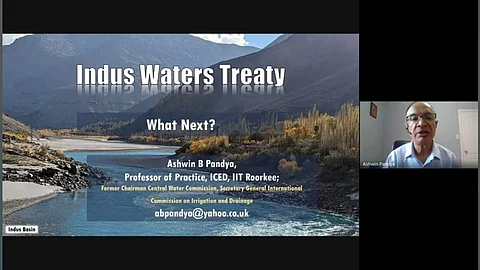
- News Updates
- PSU Watch
- Defence News
- Policy Watch
- हिन्दी न्यूज़
- Jobs Watch
- States News
- Event News

New Delhi: New Delhi-based think tank Security and Policy Initiatives (SAPI) hosted a webinar on Saturday (Aug 09) titled “Indus Water Treaty: What’s Next?”, bringing together experts from diverse fields to deliberate on the implications of the treaty being held in abeyance and its potential role in India’s strategic calculus.
Opening the discussion, SAPI founder and former technocrat Pradeep Gupta said the objective was to “understand the implications of the Indus Water Treaty in abeyance, the technical issues involved and the measures & options that can be linked to strategic actions required to stop cross-border terrorism.”
Delivering the keynote address, Prof. Ashwin B. Pandya, Professor of Practice at IIT Roorkee in Dam Safety and Visiting Senior Fellow at the Centre for Policy Research, underscored the importance of maintaining the treaty in abeyance rather than abrogating it. “With abeyance, all past restrictions are now not applicable, enabling India to proceed with dam construction, hydropower generation and storage projects that were previously constrained under the treaty,” Pandya observed. He cautioned that abrogation, unlike abeyance, could open the door for new external players, including China, to attempt to intervene in negotiations.
Pandya provided a detailed overview of the Indus river system, explaining the division of eastern and western rivers under the treaty, and highlighted how restrictions had earlier limited India’s ability to desilt dams and exploit the western rivers for socio-economic benefit. He argued that the treaty had placed disproportionate emphasis on securing Pakistan’s water needs while impeding India’s own hydropower and agricultural projects.
Citing statements by Pakistan Army Chief Field Marshal Aseem Munir, Pandya said that references to Kashmir as Pakistan’s “jugular vein” were, in effect, acknowledgments of the strategic centrality of the Indus river system to Pakistan’s survival. He noted that the bulk of Pakistan’s agricultural economy is concentrated in Punjab province, while regions such as Sindh and Baluchistan have frequently been deprived of water—an imbalance that could worsen if India altered water flows. “Timing and quantity of water release can be strategically managed—denying supply when Pakistan needs it most while releasing it when it is less useful,” he suggested.
The webinar also touched upon Pakistan’s reluctance to review the treaty despite changing technical and political circumstances. Pandya stressed that India has yet to fully utilize its share of the eastern rivers, with substantial volumes still flowing into Pakistan. “By reclaiming what is due to us, Pakistan will inevitably face water shortages,” he said, urging coordinated strategic management of dam operations.
Among his recommendations were accelerating dam construction across the Chenab and other river systems, creating new storage capacity, and developing canal networks to maximize irrigation and hydroelectric benefits for Indian states, particularly in the northwest. He maintained that such steps would not only strengthen India’s agricultural security but also mitigate regional socio-political tensions.
On security concerns, Pandya reassured participants that India’s dams are structurally capable of withstanding significant shocks, including missile attacks, being designed to face seismic activity up to “8 Richter scale.”
The session concluded with a lively Q&A, focusing on how water resource management could serve as a strategic tool for India in the face of cross-border terrorism and shifting regional geopolitics.
(PSU Watch– India's Business News centre that places the spotlight on PSUs, Bureaucracy, Defence and Public Policy is now on Google News. Click here to follow. Also, join PSU Watch Channel in your Telegram. You may also follow us on Twitter here and stay updated.)
